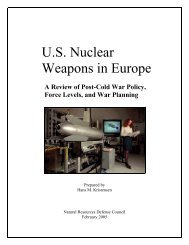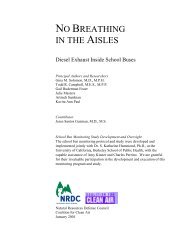p.53-94 (pdf) - Natural Resources Defense Council
p.53-94 (pdf) - Natural Resources Defense Council
p.53-94 (pdf) - Natural Resources Defense Council
You also want an ePaper? Increase the reach of your titles
YUMPU automatically turns print PDFs into web optimized ePapers that Google loves.
Appendix C U.S. Nuclear Weapons, Location Profiles, CONTINUED<br />
The Bangor base was originally established as the Naval Ammunition Depot (Bangor Annex) in<br />
1<strong>94</strong>4 to ship and store ammunition and explosives. It went through various name changes and<br />
consolidations with other nearby facilities in the 1950’s and 1960’s but later fell into disuse. A threeyear<br />
study that considered 88 potential continental and foreign sites to base the new class of Trident<br />
SSBNs concluded in February 1973 that Bangor was the best. Powerful Senators like Henry Jackson<br />
may have had something to do with the final selection.<br />
Construction began in 1974 and was completed in 1981. On October 1, 1982 the USS Ohio (SSBN<br />
726) went on its first patrol from Bangor. Over the next five years seven more SSBNs would arrive<br />
and deploy from Bangor. The eighth, the USS Nevada (SSBN 733) deployed in August 1987.<br />
Fairchild AFB began as the Spokane Army Air Depot and served from 1<strong>94</strong>3 until 1<strong>94</strong>6 as a repair<br />
depot for damaged aircraft returning from the Pacific theater. In 1<strong>94</strong>7 the base was transferred to the<br />
Strategic Air Command and assigned to 15th Air Force. The main unit over the years has been the<br />
92d Bombardment Wing. The base has hosted B-29, B-36, B-52, and, for a time from 1961 to 1965,<br />
nine Atlas E ICBMs.<br />
Fairchild AFB was one of the first bases to receive nuclear weapons in the early days of the Cold<br />
War. The nuclear weapons storage area (WSA) at Fairchild was initially constructed by the AEC<br />
between 1950 and 1952 as one of 13 original facilities built for storage, maintenance, and operational<br />
readiness of the nuclear stockpile. The storage area was originally separate from Fairchild AFB and<br />
known as Deep Creek Air Force Station (AFS). The complex originally included two storage buildings<br />
with vaults (“A” structures), a maintenance building (“C” structure), two other assembly/maintenance<br />
buildings, two types of storage igloos, and a dry low-level radioactive waste disposal area.<br />
In the early 1990s during a time of base closings, consolidations, and reorganization of commands<br />
Fairchild lost its B-52s but not its nuclear weapons. The B-52s of the 92d Bomb Wing were<br />
reassigned to other units beginning in December 1993. The last bomber left on May 25, 19<strong>94</strong>. In July<br />
19<strong>94</strong> the 92d Bomb Wing became the 92d Air Refueling Wing, assigned to Air Mobility Command<br />
(AMC).<br />
The 92d Air Refueling Wing has an odd status, fully nuclear certified and operating a Weapons<br />
Storage Area (WSA) even though bombers have left the base. The 92nd Wing received the 1995<br />
Safety Office of the Year Award, recognizing the “Excellent” rating in the first-ever combined AMC/<br />
ACC Nuclear Surety Inspection conducted during March 1995. Air Combat Command conducted<br />
Nuclear Staff Assistance Visits (NSAVs) at Fairchild in July 1993, October 19<strong>94</strong>, and March 1996.<br />
The Weapon Storage Area is being used to store the bomber weapons that are part of the “hedge”<br />
and/or reserve stockpile. The START II Treaty requires that, “Each Party shall locate storage areas<br />
for heavy bomber nuclear armaments no less than 100 kilometers from any air base where heavy<br />
bombers reoriented to a conventional role are based.” (Article IV, Section 10) The Treaty does permit<br />
bombers reoriented to a conventional role to be returned to a nuclear role. The weapons at Fairchild<br />
seems to be for such a future contingency.<br />
Worldwide Nuclear Deployments 1998 71
















